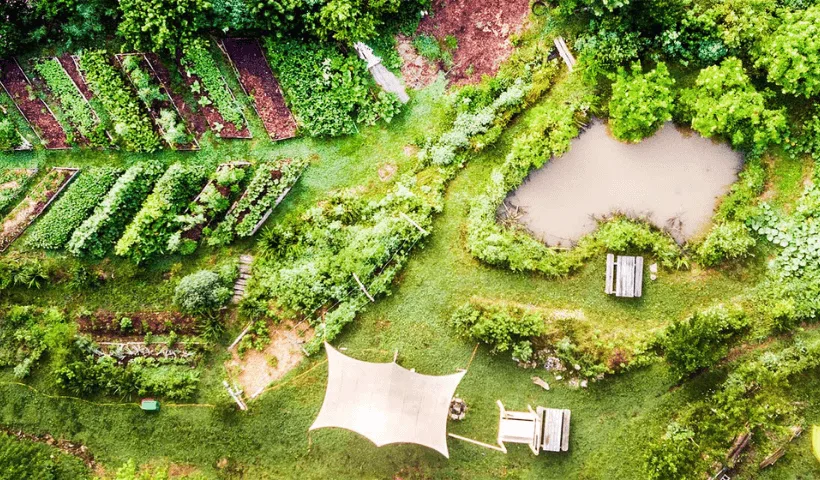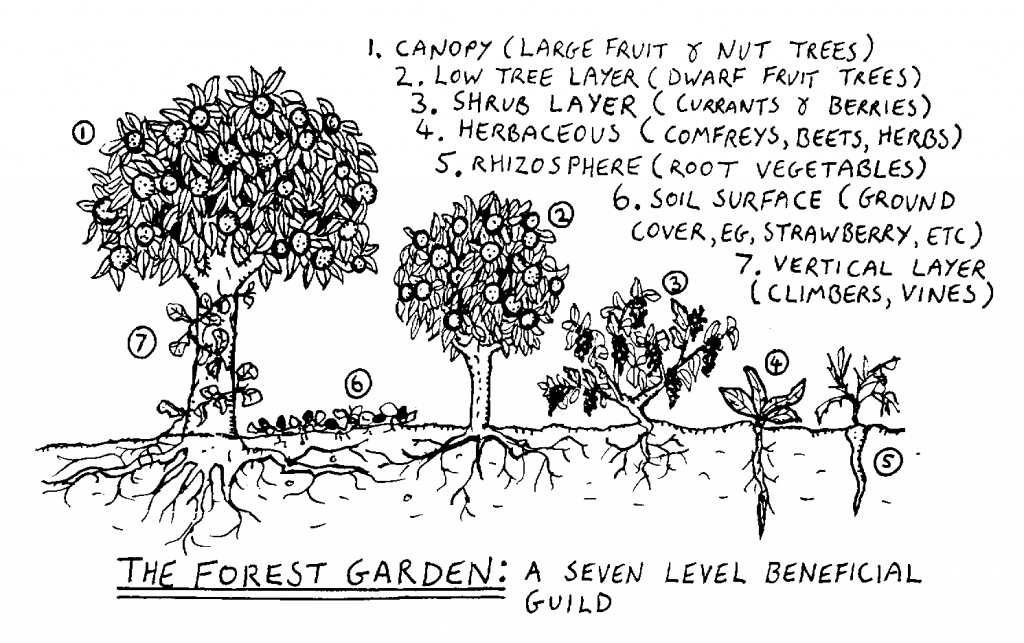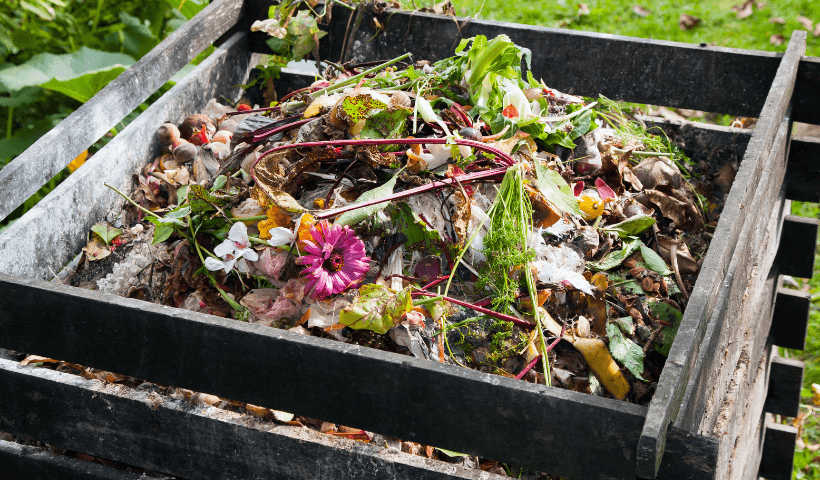If you’ve poked around in the homesteading corner of the world, chances are you’ve heard about permaculture.
Permaculture is an awesome set of principles and a way of life that tries to imitate natural processes as closely as possible. Anyone interested in homesteading, landscaping, gardening, and becoming more eco-friendly will benefit greatly from learning more about it.
This is meant to be a basic introduction to the idea and principles of permaculture.
We will touch on what permaculture is, its history, why it’s beneficial, and reasons to pursue it. Let’s dive in!
If you’re already familiar with permaculture and want to dive right in, we suggest reading these 5 Best Permaculture Books.
Check out our other permaculture resources:
– The 12 Permaculture Principles
– The 6 Permaculture Zones and How To Use Them
What Is Permaculture?
Permaculture is a way to meet human needs through regenerative design and management of land.
It integrates land, resources, people, and the environment through mutually beneficial synergies, imitating the closed-loop, no waste systems seen in diverse natural ecosystems.
This is achieved by way of activities, methods, techniques, principles, and practices that harness and mimic the process of the natural world. Later in this article, we give some examples of these methods.
Definitions Of Permaculture
There are many different definitions of permaculture and its principles are very flexible in interpretation.
This is awesome because it allows everyone to manifest the subject in their own unique way. However, this makes it difficult to formulate a concrete definition.
Here is one definition, taken from Practical Permaculture by Jessi Bloom & Dave Boehnlein:
“Meeting human needs through ecological and regenerative design.”
Concise and simple to understand.
Another definition comes from Ben Falk in his book The Resilient Farm and Homestead: “
“In essence, permaculture as a land-use approach is a system of ecological regeneration in which the production of products for human livelihoods is also a key component – a marriage of ecological restoration and gardening if you will.“
As you can see, formative definitions for the permaculture body of thought have been developed by many.
We have developed our own meaning here at Life Lived Curiously:
“An integration of ecological components and processes into human-directed applications that solve wants and needs sustainably, creating a richer, more productive environment as a result. “
After reading, learning, and implementing different permaculture techniques, this is the description we think fits best. As you get more into permaculture, you might come up with your own definition!

A Brief History Of Permaculture
The word “permaculture” was coined in the 1970s by Bill Mollison, who is considered the co-founder and father of the permaculture movement.
Although the official term permaculture is relatively new, the concept is much older.
People have been harnessing and mimicking the processes of the natural world in beneficial ways for a long time. Over millennia, in fact.
Many Indigenous tribes were using regenerative gardening techniques for centuries before it was ever “branded.”
The Aztecs famously used floating gardens, called chinampas, to grow food without causing harm to the environment. The Iroquois were known for implementing companion gardening with corn, beans, and squash, which they called the “Three Sisters.” Agroforestry techniques have been used by Indigenous peoples all over the world for a very long time.
These methods are all now considered a part of permaculture and are used by regenerative gardeners across the globe.
The 12 Principles of Permaculture
David Holmgren, one of the original architects of the “permaculture” term as it is now used, created the following 12 permaculture principles to help put the body of thought into practice.
These principles are seen as universal, although the methods used to express them will vary greatly according to the place and situation. They can apply to our lives personally, economically, socially, and politically.
We have a more in-depth article on these principles here, but for now, here is a quick look, as written by Holmgren:
1. Observe and interact
2. Catch and store energy
3. Obtain a yield
4. Apply self-regulation and accept feedback
5. Use and value renewable resources and services
6. Produce no waste
7. Design from patterns to details
8. Integrate rather than segregate
9. Use small and slow solutions
10. Use and value diversity
11. Use edges and value the marginal
12. Creatively use and respond to change
Examples of Permaculture In Action
Here are a few examples of permaculture techniques in action. This will give you a visual idea of some ways permaculture can be implemented!
We’ve just chosen a few to highlight here – this is nowhere near an exhaustive list.
1. Hugelkultur Mounds
Hugelkultur mounds are made from layering different forms of biomass, such as decaying logs, branches, leaves, grass clippings, and compost on top of each other to create a natural raised garden bed. This nutrient-dense mound decomposes over time into incredibly rich humus.
While the mound seasons and breaks down, you can use it to grow vegetables or other plants. Newly-established hugelkultur mounds are excellent for growing vining plants such as squash, zucchini, pumpkins, watermelon, and cucumbers.
Hugelkultur mounds are an excellent way to create a closed-loop, no-waste system of resources on your property.
To learn more, read our Ultimate Guide To Hugelkultur Gardening.

2. Forest Gardening
A forest garden is created by intentionally planting productive crops and plants to mimic the natural structure of a forest.
Instead of neat rows of monoculture, forest gardens mix a diverse range of (often) food-producing plants that nourish each other, use different nutrients from the soil, and make the best use of the space available.
It involves utilizing several defined layers of the forest to use shade and sunlight as efficiently as possible. Look at the picture below and notice how several types of productive food crops are intermixed with trees and shrubs to maximize available sunlight and ground space.

3. Swales
A swale is a shallow trench dug along the contour of gently sloped land. Dirt dug out from the trench is then used to create a berm, or a flat strip of land, on the downhill side of the swale.
Swales are a great way to naturally capture rainwater. Once rainwater collects in the swales, it then slowly sinks into the ground downhill, underneath the berm. If you grow plants on the berm, they essentially become self-watering! (with enough rainfall, of course)
This is a great way to make a natural irrigation system for your garden if you have any gently sloping land. The video below gives an awesome visual example of swales and berms.
4. Composting
This is the example you’re probably most familiar with on this list of examples.
Composting is the natural process of recycling organic matter, such as leaves and food scraps, into a valuable fertilizer that can enrich soil and plants. So, instead of disposing of valuable biomass in the garbage, it is repurposed into nutrients that get put back into your garden.
There are several ways to compost, including with worms, in a large rotating bin, or just in a big pile outside.
We will be posting a guide to composting soon, but for now, if you’d like more information, here’s an informative article to get you started.

5. No-Till Gardening
This is one of the most popular and important techniques of permaculture! No-till gardening is exactly what it sounds like – avoiding the intentional disruption of soil.
Instead of mixing amendments deep into the soil, slow-release organic fertilizers, compost, and/or mulch materials are added to the top of the soil on occasion. Those things, along with the left-behind plant roots, slowly break down to rejuvenate the soil and provide food for new plants.
Apart from simply not tilling the ground you plant in each year, raised garden beds are another way to achieve no-till status.
Avoiding soil disruption imitates natural processes – soil is never tilled in a natural environment, such as a meadow or forest.
No-till gardening prevents soil erosion and depletion of nutrients, in addition to promoting a closed-loop system.
Reasons To Pursue Permaculture
There are many reasons people follow the permaculture lifestyle and principles.
Some use it as a means to counteract or reduce the effects of anthropogenically-induced issues. This may involve building a resilient property in the face of drastically changing climatic conditions. Or maybe conserving and/or regenerating natural resources that have been eliminated or adversely affected by human activity.
Others pursue permaculture as a means to derive sustenance for the body, mind, and spirit through an entwined ecological coexistence. These people may be looking to grow wholesome food and create pleasant, functional natural spaces that help them heal, reflect, and be happier.
Permaculture is a pliable framework that you can use to achieve your specific preferences.
For us, permaculture is so many things. It’s a mindset, application, therapy, reprieve from a misguided world, and a commitment to an ideal that is wholesomely good. It’s a gift that benefits every living element involved.
Permaculture to us is about biodiversity, personal enlightenment, natural solutions, self-reliance, and a desire to give back to the Earth.
Goals Of Permaculture
Now that you have a basic idea of what permaculture is, we want to illustrate some tangible examples of what can be accomplished with permaculture.
Here are some specific examples of what we hope to accomplish through permaculture.
- Create a rich, ecologically-productive property through restorative practices that support and enhance conditions for a vibrant array of both flora and fauna diversity.
- Produce wholesome, organic food in a way that is integrated with the land. This is in contrast to conventional, disruptive manners of food production that cause harm or degradation to the environment and the life residing within it.
- Preserve naturally-occurring food sources on our property. Make these existing stocks more prolific by enriching the microclimates around the areas that are producing berries, nuts, and mushrooms.
- Capture and put to good use the water resources that would normally be lost or unusable in the form of runoff from impervious surfaces.
- Slow, spread, and sink water that moves across the surface of the property in order to maintain and recharge the groundwater supply below.
- Sustainably cultivate and harvest fuel for a carbon-neutral, wood-burning heat source.
- Create a permanent water fixture on our property in the form of a small pond that is filled and perpetuated through natural processes that will provide aesthetics, wildlife habitat, and a source of additional water for various needs and projects that may arise.


The Best Permaculture Books To Read in 2022 - Modern Day Self Reliance
Tuesday 27th of September 2022
[…] If you don’t know what permaculture is or are unsure if you’re ready to invest time and money into buying books, check out our short intro to permaculture here. […]
The 6 Permaculture Zones and How To Use Them - Modern Day Self Reliance
Tuesday 27th of September 2022
[…] starting to learn about permaculture or need a longer refresher, check out our introductory article What Is Permaculture? An Introduction To Regenerative Gardening. We also wrote The 12 Permaculture Principles and The 5 Best Permaculture Books to Read in […]
The 12 Permaculture Principles - Modern Day Self Reliance
Monday 26th of September 2022
[…] more about permaculture from these articles:– What Is Permaculture? An Introduction To Regenerative Gardening– The 6 Permaculture Zones and How To Use Them– The 5 Best Permaculture Books To […]